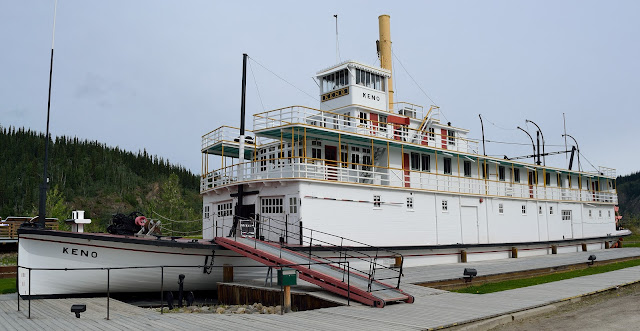We started our day souvenir shopping then went to see the S.S. Keno which is a National Historic Site. Constructed in 1922, the S.S. Keno was the smallest of the British Yukon Navigation Company’s fleet. Her primary job was to transport silver ore from Mayo mining district to the Yukon River at Stewart Crossing. However in the spring and fall when the Yukon River is at its lowest the S.S. Keno with its shallow draft made the first and last trips of the season from Dawson to Whitehorse. This sternwheeler provided a vital link to the outside world for those living in Dawson City. On her last trip in 1960 the S.S. Keno was brought back down river from Whitehorse to rest in her current location on Dawson’s waterfront.
Each fall, the freezing river stopped all sternwheeler travel and the ships were hauled ashore using capstans. Sternwheelers, some over 700 tons were hauled ashore by labouring horses.
Another stop we made was at the original cabin of poet Robert Service. Parks Canada now owns this building and offers tours and readings of his work.
In 1897 at the age of 21, Jack London left San Francisco to join the Klondike Gold Rush. He hiked the Chilcoot Pass, and as a skilled boatman navigated Miles Canyon and the Whitehorse Rapids. He travelled the Yukon River to find himself in Dawson for the summer and winter. He tried his hand at prospecting but never found any gold. Penniless and sick he returned to California. The Klondike had a major influence on his writing with novels like The Call of the Wild and White Fang. This site contains some of the logs that were used in the original Jack London cabin.
The massive scar on the hillside to the north is a prehistoric landslide, and not the result of mining activity. The Dawson City landslide, known locally as Moosehide Slide is a dominant feature of Dawson’s cityscape. For centuries, spotting Moosehide Slide has marked the ed of the journey for people travelling down the Yukon River to the Klondike.
It’s hard being a tourist, we seem to be hungry allot. So why fight it. We went out for an early supper late lunch. We chose Sourdough Joes Restaurant. The food was great. Then we went next door for ice cream.
Not that we needed more to eat, but we stopped anyway at the local bakery because it was just next door to the ice cream place. Yes, we couldn’t resist. We picked up a couple of cheese & pepper biscuits and Susan wanted a couple of sticky buns. Fifteen dollars later we walked out, yes things are more expensive here than back home. Do we care…nope because it’s all about the adventure.
Across the road is a tribute statue to the miners who staked the first claims on Bonanza and Eldorado Creek back in 1896.
The Yukon River is the third longest river in North America 3185 km or 1980 miles, after the Mississippi and Mackenzie. It drains and immense basin of more than 840,000 square kilometres or 325,000 square miles, an area 25% larger than Texas or Alberta.
The Yukon River was named by the Hudson’s Bay Co. trader John Bell in 1846. “Youcon” was Bell’s version which means “great river” in Athabaskan, the people of Northern Yukon. If you so desire you can take a narrated old fashion paddlewheeler cruise on the Yukon River. We chose not to at this point, not enough time.
We decided to spend an evening out at Diamond Tooth Gerties Gambling Hall. Susan and I gambled a little (Susan more than me) but the real fun was the live entertainment. It featured Diamond Tooth Gertie and her Can-Can Girls. The first show was at 8:30. There’s also a midnight show but we all knew we would be asleep. The show was sooooo much fun.
Its midnight and the sun is shining just as if it was 12 noon. No wonder I’m finding it hard to sleep.














No comments:
Post a Comment